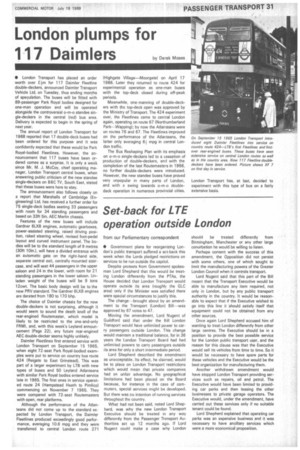London plumps for
Page 33

If you've noticed an error in this article please click here to report it so we can fix it.
117 Daimlers byDerekMoses
• London Transport has placed an order worth over Elm for 117 Daimler Fleetline double-deckers, announced Daimler Transport Vehicle Ltd. on Tuesday, thus ending months of speculation. The buses will be fitted with 89-passenger Park Royal bodies designed for one-man operation and will be operated alongside the controversial o-m-o standee single-deckers in the central (red) bus area. Delivery is expected to begin in the spring of next year.
The annual report of London Transport for 1968 reported that 17 double-deck buses had been ordered for this purpose and it was confidently expected that these would be Park Royal-bodied Fleetlines. However, the announcement that 117 buses have been ordered comes as a surprise. It is only a week since Mr. M. J. McCoy, chief operating manager, London Transport central buses, when answering public criticism of the new standee single-deckers on BBC TV, South East, stated that these buses were here to stay.
The announcement also follows closely on a report that MarshaIls of Cambridge (En gineering) Ltd. has received a further order for 75 single-deck bodies seating 33 passengers with room for 34 standing passengers and based on 33ft 5in. AEC Merlin chassis.
Features of the new buses will include Gardner 6LXB engines, automatic gearboxes, power-assisted steering, raised driving posi tion, raked steering wheel, revised foot-pedal layout and curved instrument panel. The bo dies will be to the standard length of 9 metres (30ft 10in.), will have a divided entrance with an automatic gate on the right-hand side, separate central exit, centrally mounted staircase, and will seat 44 passengers in the upper saloon and 24 in the lower, with room for 21 standing passengers in the lower saloon. Unladen weight of the buses will be 9 tons 12cwt. The basic body design will be to the new PRV standard. The Gardner 6LXB engines are derated from 180 to 170 bhp.
The choice of Daimler chassis for the new double-deckers is not surprising, although it would seem to sound the death knell of the rear-engined Routemaster, which model is likely to be restricted to the one-and-only FRM I, and, with this week's Leyland announcement (Page 22), any future rear-engined AEC double-decker seems highly unlikely.
Daimler Fleetlines first entered service with London Transport on September 15 1965, when eight 72-seat Park Royal-bodied examples were put to service on country bus route 424 (Reigate to East Grinstead). This was part of a larger experiment by LTB with new types of buses and 50 Leyland Atlanteans with similar Park Royal bodies entered service late in 1965. The first ones in service operated route 24 (Hampstead Heath to Pimlico) commencing on November 7 1965. They were compared with 72-seat Routemasters with open, rear platforms.
Although the performance of the Atlanteans did not come up to the standard expected by London Transport, the Daimler Fleetlines produced exceedingly good performance, averaging 10.6 mpg and they were transferred to central London route 271 (Highgate Village—Moorgate) on April 17 1966. Later they returned to route 424 for experimental operation as one-man buses with the top-deck closed during off-peak periods.
Meanwhile, one-manning of double-deckers with the top-deck open was approved by the Ministry of Transport. The 424 experiment over, the Fleetlines came to central London again, operating on route 67 (Northumberland Park– Wapping); by now the Atlanteans were on routes 76 and 67. The Fleetlines improved on the performance of the Atlanteans, the latter only averaging 6; mpg in central London traffic.
The Bus Reshaping Plan with its emphasis on o-m-ci single-deckers led to a cessation of production of double-deckers, and with the completion of the last Routemasters in 1966, no further double-deckers were introduced. However, the new standee buses have proved very unpopular in many parts of London, and with a swing towards o-m-o doubledeck operation in numerous provincial cities, London Transport has, at last, decided to experiment with this type of bus on a fairly extensive basis.
















































































































